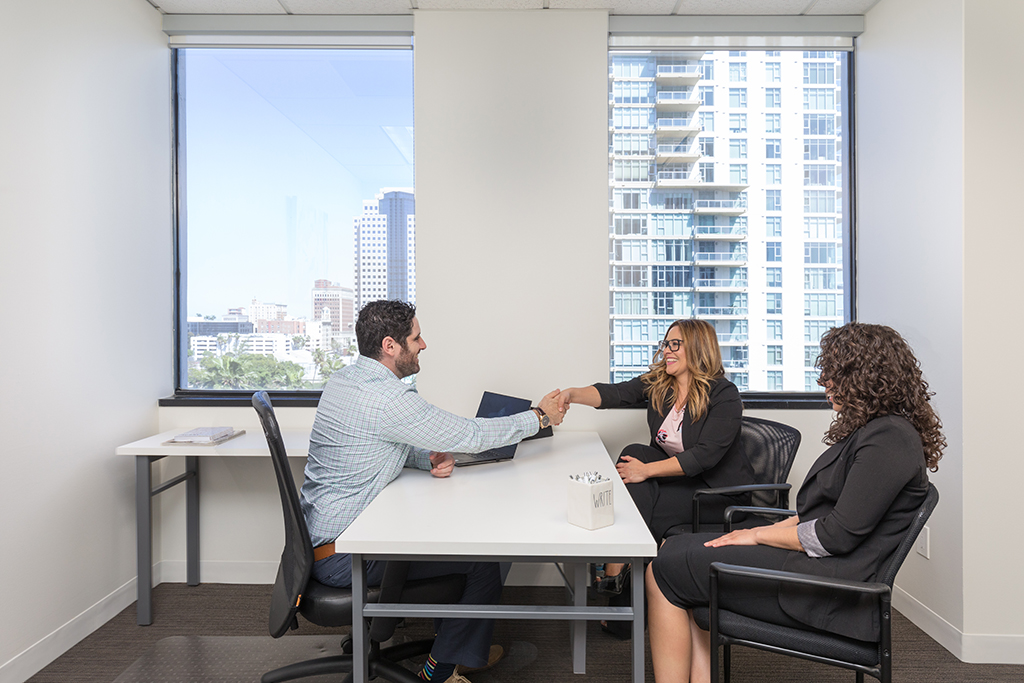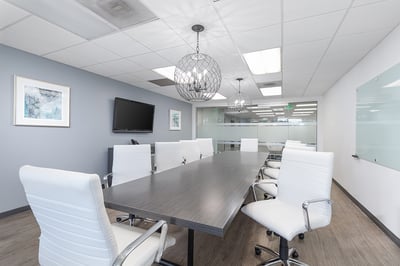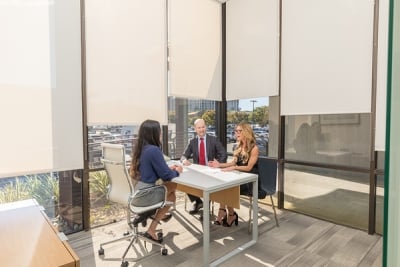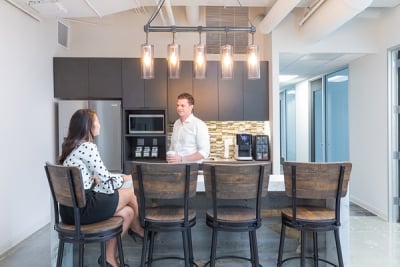- Book a Space
- Locations
- California
- Aliso Viejo
- Anaheim Hills
- Beverly Hills
- Burbank
- Calabasas
- Carlsbad
- Century City
- Cerritos
- Concord
- Culver City
- El Segundo
- Foothill Ranch
- Huntington Beach
- Irvine
- Irvine Spectrum
- Long Beach
- Los Angeles - Brentwood
- Los Angeles - Downtown
- Los Angeles - West Los Angeles
- Los Angeles - Westwood
- Manhattan Beach
- Mission Viejo
- Newport Beach
- Oakland
- Orange
- Panorama City
- Pasadena
- Rancho Cucamonga
- Rancho Santa Margarita
- San Diego - Del Mar
- San Diego - Downtown
- San Diego - La Jolla
- San Diego - Mission Valley
- San Diego - Rancho Bernardo
- San Francisco
- San Jose
- Santa Monica
- Sherman Oaks
- Temecula
- Torrance
- Westlake Village
- Woodland Hills
- Arizona
- Hawaii
- Illinois
- Nevada
- New Jersey
- New York
- North Carolina
- Ohio
- Texas
- Washington
- Washington DC
- California
- Workspaces
- About
- Contact Us
- Client Login

Private Workspace Must-Haves: The Essential List
What can you expect when you rent a private workspace? Four walls? Four walls plus a desk and a chair?
Likely you will get more than that out of your arrangement, but the offerings may differ among companies that provide private workspaces and shared and coworking spaces.
Find out what’s commonplace and what’s considered gravy when you rent a private workspace.
 Healthy Spaces
Healthy Spaces
We’ve come a long way from the sweatshops that were commonplace at the turn of the 20th century. Conditions for workers were unsafe, unhealthy and often downright treacherous.
Congress passed laws over the years to improve such conditions, and workers have gotten used to climate-controlled, properly lit, more welcoming workspaces. But in today’s competitive market, the bare minimum isn’t enough.
New products introduced to the construction market with the expectation that they will bring consumers convenience and comfort are sometimes proven to be otherwise. For instance, certain types of chemicals in PBCs have shown to have adverse effects on some people’s health. VOCs in carpeting, arsenic in wood and various components of paint can all wreak havoc on a building’s occupants, causing headaches, runny noses, fatigue, and a host of flu-like symptoms.
Today, when companies hire firms to do office buildouts, they more often stress using green building materials to limit the effect of toxins in the workplace. Many locations, including Premier Workspaces locations, are LEED certified.
When you rent a private workspace, you have every right to expect it to be free of any potentially dangerous materials or toxic smells (unless your coworker is microwaving fish again, but that’s another post).
Ergonomic Furniture
Ergonomic furniture is a subset of healthy workspaces. After all, if your private workspace doesn’t prioritize ergonomics in their furniture selection, you may soon feel less than healthy working there.
Ergonomics is most important when we’re talking about desks and chairs.
When you sit in a chair, your feet should rest flat on the floor. If your feet are not fully supported, you risk back strain. Since we are all different sizes, proper work chairs should be adjustable.
Today, “standing desks” have become popular, as well as stools, rubber balls and various other types of contraptions. While these are not all standard in any office, adjustable desks and chairs are an expected part of the landscape.
Cutting-edge Technology
A workspace without good WiFi defies the “work” part of the term because you can’t get any work done without WiFi. The more people you have sharing the connection, the slower it can get. Smart coworking spaces know that slow WiFi is a death knell for their business.
How many public spaces have you sat in, feeling your blood pressure rise as you wait for your page to load? Eventually, people give up. They stand up, snap their laptops shut, and stalk off in search of a better connection.
That kind of service has a name, and it’s called “free.” Libraries, municipal buildings, and schools often provide free WiFi, so it doesn’t have to be fast or allow you to see the websites you need to view. (However, most astute providers of public or shared WiFi will block porn sites, as these are rife with viruses, bugs, and spyware. But you don’t want to be locked out of social media or shopping sites, as these are often necessary to your work.)
You’re not a valued customer at a public park or the Greyhound terminal, and they lose nothing if you storm off. In fact, it will leave more bandwidth for those who remain.
But when you are a paying customer, you can expect more. WiFi in a coworking building should be fast, should allow full access to most sites, should go down only in cases of emergency, and should offer full protections.
Besides great WiFi, your coworking space should provide you access to the newest and best office equipment, such as printers, copiers, presentation hardware and software, scanners, shredders and all the little things no one has time to worry about, like pens and paper, rubber bands, file folders, and more.
If each small-business owner who rented a coworking space had to get their own office supplies, it would result in a huge, unnecessary expense. Plus each would need to find room for these items as well.
Sharing is caring — for your wallet, and the environment.
 Flexible Spaces
Flexible Spaces
When you rent a private workspace, you have choices.
Do you want to sit in a large, communal room with others? This is usually the cheapest option.
Or do you want a small space to call your own where you can put a picture of your cat and the “paperweight” (read: painted rock) your granddaughter gave you for your birthday?
Maybe you would prefer a larger space with room for meetings with clients. Or how about the granddaddy of them all — a large corner office with windows and room for a desk, meeting area, couch and coffee table?
With shared working spaces, you should be able to choose from among all these options.
Further, you should have options that allow you to move from one workspace to another when necessary.
For instance, if you have set up shop in a common area, your provider should offer the option to rent a small office space for a private meeting, or a large meeting room with equipment for making presentations to groups.
Coworking spaces should also have phone booths, or areas where workers can go to take and make phone calls. It doesn’t matter whether you’re talking to your mom about a birthday dinner or a client about a big deal you have in the works, you are entitled to some privacy. And even if you don’t care about privacy, likely your coworkers will appreciate you conducting your chats behind a door that closes and keeps the sound in.
A break room with a kitchen is also usually part of a coworking space. Having a refrigerator, microwave, and coffeemaker at your disposal 24/7 is a fabulous benefit. The time and expense you would otherwise have to spend by going out for food, snacks, and coffee can add up quickly.
 And having a kitchen and break room on-site is not just handy, it’s helpful for meeting others in your coworking space. You can network, learn new things, make friends and take rejuvenating breaks away from work to chat. Not the social type? Heat up your pizza and take it back to your desk (not in a coworking area though, ew).
And having a kitchen and break room on-site is not just handy, it’s helpful for meeting others in your coworking space. You can network, learn new things, make friends and take rejuvenating breaks away from work to chat. Not the social type? Heat up your pizza and take it back to your desk (not in a coworking area though, ew).
As if all these flexible office space solutions aren’t enough, many locations are in buildings that also allow our tenants to use their facilities such as the fitness center, pool, parking lot, lounge, patio, and party rooms. It’s like belonging to a club!
This kind of convenience is what helps make coworking spaces popular. You don’t need to lease space that provides for every possible scenario. Save money and share, using only what you need, when you need it.
Friendly, Helpful Staff
Wouldn’t it be nice to have a personal assistant? Someone who could help you whenever things got crazy? Well, Premier Workspaces has you covered — during work hours anyway.
One of the top reasons clients love Premier Workspaces for their private workspace is because we have the friendliest, most helpful employees on staff. One of our customers said, “The ladies who work the front desk at our office couldn’t be better and more attentive to our needs.”
Frequently, in our reviews, our clients refer to the staff members by name, because we have taken the time to get to know them and have formed relationships. They know they can count on us, whether they need more paper for the copy machine, help with the telephone system or a recommendation for a great spot for lunch.
Our customers rave about how the staff is not only attentive and professional with them, but with their clients who visit as well, improving their business and their reputation in the community.
The benefits of using private workspaces and coworking spaces are virtually endless. Now that you know what to expect out of your coworking space, you’ll know what’s top-notch, and what’s substandard.
To find out more about the best in coworking, shared and private workspaces, contact your local Premier Workspaces today.

